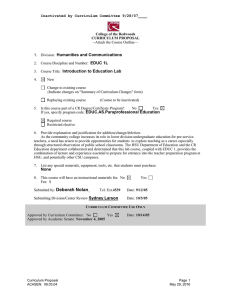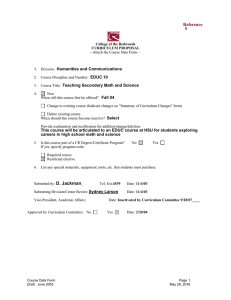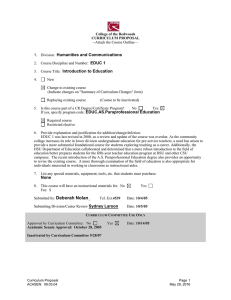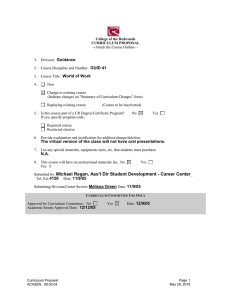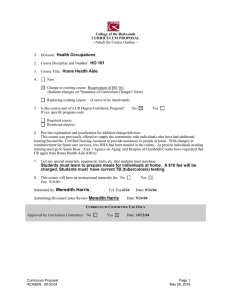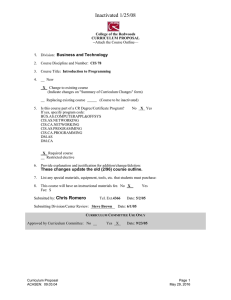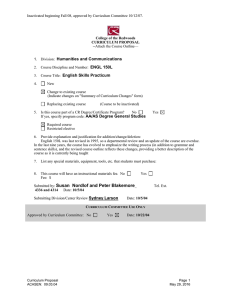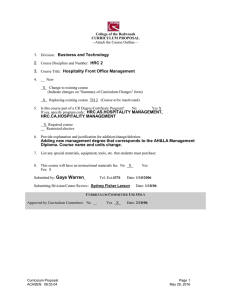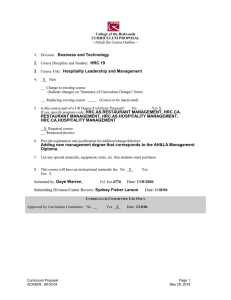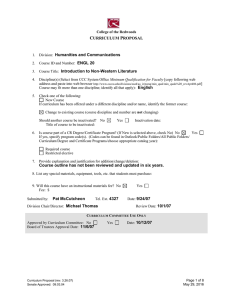Positive Guidance in the Classroom Humanities and Communication
advertisement
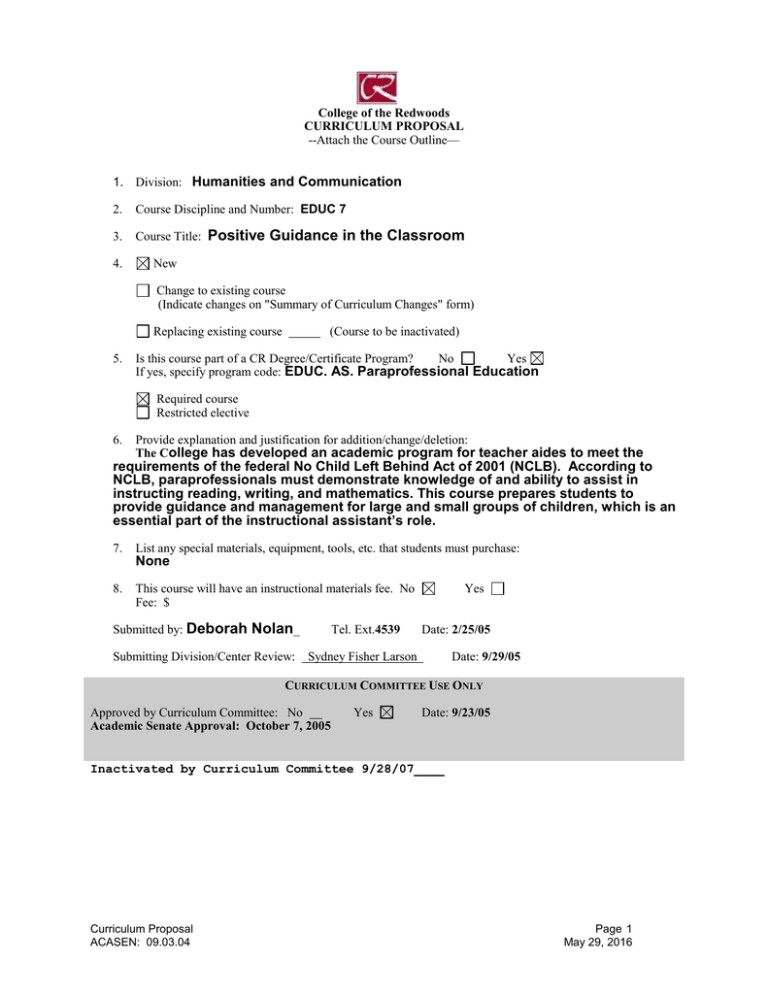
College of the Redwoods CURRICULUM PROPOSAL --Attach the Course Outline— 1. Division: Humanities and Communication 2. Course Discipline and Number: EDUC 7 3. Course Title: 4. New Positive Guidance in the Classroom Change to existing course (Indicate changes on "Summary of Curriculum Changes" form) Replacing existing course 5. (Course to be inactivated) Is this course part of a CR Degree/Certificate Program? No Yes If yes, specify program code: EDUC. AS. Paraprofessional Education Required course Restricted elective 6. Provide explanation and justification for addition/change/deletion: The College has developed an academic program for teacher aides to meet the requirements of the federal No Child Left Behind Act of 2001 (NCLB). According to NCLB, paraprofessionals must demonstrate knowledge of and ability to assist in instructing reading, writing, and mathematics. This course prepares students to provide guidance and management for large and small groups of children, which is an essential part of the instructional assistant’s role. 7. List any special materials, equipment, tools, etc. that students must purchase: None 8. This course will have an instructional materials fee. No Fee: $ Submitted by: Deborah Nolan_ Submitting Division/Center Review: Tel. Ext.4539 Yes Date: 2/25/05 Sydney Fisher Larson Date: 9/29/05 CURRICULUM COMMITTEE USE ONLY Approved by Curriculum Committee: No Academic Senate Approval: October 7, 2005 Yes Date: 9/23/05 Inactivated by Curriculum Committee 9/28/07____ Curriculum Proposal ACASEN: 09.03.04 Page 1 May 29, 2016 SUMMARY OF CURRICULUM CHANGES FOR AN EXISTING COURSE FEATURES OLD NEW Catalog Description Grading Standard Units Lecture Hours Lab Hours Prerequisites Corequisites Recommended Preparation Maximum Class Size RepeatabilityMaximum Enrollments Other If any of the listed features have been modified in the new proposal, indicate the "old" (current) information and proposed changes. Course Outline Senate Approved: 09.03.04 2 May 29, 2016 College of the Redwoods Course Outline DATE: 9/1/05 DISCIPLINE AND COURSE NUMBER: EDUC 7 FORMER DISCIPLINE AND NUMBER (If previously offered): COURSE TITLE: Positive Guidance in the Classroom TOTAL UNITS: 3 [Lecture Units: 3 Lab Units: TOTAL HOURS: 54 [Lecture Hours: 54 Lab Hours: ] ] MAXIMUM CLASS SIZE: 40 GRADING STANDARD: Letter Grade Only CR/NC Only Is this course repeatable for additional credit units: No Grade-CR/NC Option Yes how many total enrollments? Is this course to be offered as part of the Honors Program? No Yes If yes, explain how honors sections of the course are different from standard sections. CATALOG DESCRIPTION: The catalog description should clearly state the scope of the course, its level, and what kinds of student goals the course is designed to fulfill. Provides principles of positive guidance based on contemporary research and child development. The course focuses on application of the principles of effective communication, understanding child development and behavior, appropriate limits and rules, structuring problem solving, and consequences. Special notes or advisories: PREREQUISITES: No Yes Course: Rationale for Prerequisite? Describe representative skills without which the student would be highly unlikely to succeed . COREQUISITES: No Yes Rationale for Corequisite? Course: RECOMMENDED PREPARATION: No Yes Course: Rationale for Recommended Preparation? Course Outline Senate Approved: 09.03.04 3 May 29, 2016 COURSE LEARNING OUTCOMES: What should the student be able to do as a result of taking this course? State some of the objectives in terms of specific, measurable student accomplishments. Apply principles of positive guidance and discipline based on contemporary research and child development. Use classroom guidance and intervention strategies based on understanding child development and behavior. Establish appropriate limits and rules. Implement structured problem solving. Use effective communication to enforce appropriate consequences. COURSE CONTENT Themes: What themes, if any, are threaded throughout the learning experiences in this course? Guidance versus management Theory-to-practice Mistaken behavior versus misbehavior Professionalism Problem solving Intervention Leadership Inclusion Ethical Conduct Concepts: What concepts do students need to understand to demonstrate course outcomes? Guidance Obedience Discipline Autonomy Empathy Crisis management Equilibrium/disequilibrium Multiple intelligences Emotional intelligence Conditional acceptance Unconditional positive regard Zone of proximal development Liberation teaching Encouraging classrooms Motivation Conflict management Developmentally appropriate practice Intentionality Mistaken behavior Stigma Authentic assessment Performance assessment Collaboration Transitions Reflective listening I messages Course Outline Senate Approved: 09.03.04 4 May 29, 2016 Mediation Negotiation Cooperation Issues: What primary issues or problems, if any, must students understand to achieve course outcomes (including such issues as gender, diversity, multi-culturalism, and class)? Diversity Multi-culturalism Class Inclusion Skills: What skills must students master to demonstrate course outcomes? Reading and understanding assignments. Generating ideas appropriate to the assignment. Responding to complex readings through discussion and writing. Organizing information for essays or other assignments. Critical thinking and evaluation. REPRESENTATIVE LEARNING ACTIVITIES: What will the students be doing (i.e., Listening to lectures, participating in discussions and/or group activities, attending a field trip, etc.)? Relate the activities directly to the Course Learning Outcomes. Listening and responding to lectures. Reading and responding to a text. Participating in discussions and group activities. Listening and responding to oral presentations. Examining, practicing, and evaluating guidance strategies. Exploring and collecting guidance resources. Using technology to access resources. ASSESSMENT TASKS: How will the student show evidence of achieving the Course Learning Outcomes? Indicate which assessments (if any) are required for all sections. Representative assessment tasks: Writing reports, essay exams, quizzes, and other formal and informal writing assessments. Delivering oral presentations. Preparing graphic representations of concepts. Participating in small and large group discussions. Required assessments for all sections – to include but not limited to: EXAMPLES OF APPROPRIATE TEXTS OR OTHER READINGS Author Gartrell, D. Title (Author, Title, and Date Fields are required): A Guidance Approach for the Encouraging Classroom Date 2003 Other Appropriate Readings: MNAEYC Position Statement: Developmentally Appropriate Guidance of Young Children Course Outline Senate Approved: 09.03.04 Date 1999 5 May 29, 2016 PROPOSED TRANSFERABILITY: UC CSU None X General elective credit If CSU transferability is proposed (courses numbered 1-99), indicate whether general elective credit or specific course equivalent credit is proposed. Specific course equivalent If specific course equivalent credit is proposed, give course numbers/ titles of at least two comparable lower division courses from a UC, CSU, or equivalent institution. PROPOSED GENERAL EDUCATION: Rationale for General Education certification: BOTH 1. , (Campus) 2. , (Campus) NONE X CR UC CSU College of the Redwoods General Education Applicability: AREA Natural Science Social Science Humanities Language and Rationality Writing Oral Communications Analytical Thinking Rationale for inclusion in this General Education category: Proposed California State University General Education Breadth (CSU GE) Applicability A. Communications and Critical Thinking A1 – Oral Communication A2 – Written Communication A3 – Critical Thinking C. Arts, Literature, Philosophy, and Foreign Language C1 – Arts (Art, Dance, Music, Theater) C2 – Humanities (Literature, Philosophy, Foreign Language) B. Science and Math B1 – Physical Science B2 – Life Science B3 – Laboratory Activity B4 – Mathematics/Quantitative Reasoning D. Social, Political, and Economic Institutions D0 – Sociology and Criminology D1 – Anthropology and Archeology D2 – Economics D3 – Ethnic Studies D5 – Geography D6 – History D7 – Interdisciplinary Social or Behavioral Science D8 – Political Science, Government and Legal Institutions D9 – Psychology E. Lifelong Understanding and Self-Development E1 – Lifelong Understanding E2 – Self-Development Rationale for inclusion in this General Education category: Same as above Proposed Intersegmental General Education Transfer Curriculum (IGETC) Applicability Course Outline Senate Approved: 09.03.04 6 May 29, 2016 AREA 1A – English Composition 1B – Critical Thinking-English Composition 1C – Oral Communication (CSU requirement only 2A – Math 3A – Arts 3B – Humanities 4A – Anthropology and Archaeology 4B – Economics 4E – Geography 4F – History 4G – Interdisciplinary, Social & Behavioral Sciences 4H – Political Science, Government & Legal Institutions 4I – Psychology 4J – Sociology & Criminology 5A – Physical Science 5B – Biological Science 6A – Languages Other Than English Rationale for inclusion in this General Education category: Course Outline Senate Approved: 09.03.04 Same as above 7 May 29, 2016 FOR VPAA USE ONLY PROGRAM AND COURSE NUMBER EDUC 7 TECHNICAL INFORMATION 1. Department: HUM Humanities 16. CoRequisite Course: none 2. Subject: EDUC 17. CoRequisite Noncourse: none Course No: 7 3. Credit Type: D Credit Degree Applicable 18. Maximum Class Size: 40 4. Min/Maximum Units: 3.0 to 19. Repeat/Retake: NR No repeats variable units 5. Course Level: E Not Occupational 20. Count Retakes for Credit: yes no 6. Academic Level: UG Undergraduate 21. Only Pass/No Pass: yes no 7. Grade Scheme: UG Undergraduate 22. Allow Pass/No Pass: yes no 8. Short Title: Positive Guidance in the Classroom 23. VATEA Funded Course: yes no 9. Long Title: Positive Guid in the Classroom 24. Accounting Method: W Weekly Census 10. National ID 11. Local ID (CIP): (TOPS): 13.0101 080100 12. Course Types: Level One Basic Skills: NBS Not Basic Skills 25. Disability Status: N Not a Special Class 26. Billing Method: T-Term 27. Billing Period: R-Reporting Term 28. Billing Credits: 3.0 Level Two Work Experience: NWE Not Coop Work Experience 29. Purpose: A Liberal Arts Sciences Level Three: 30. Articulation No. Placeholder for GE OR (CAN): Choose One: 31. Articulation Seq. Level Four: If GE : Choose One: 32. Transfer Status: B Transfers to CSU only 13. Instructional Method: LEC Lecture and/or Discussion 14. Lec TLUs: 4.5 Contact Hours: 54.0 Lab TLUs: Contact Hours: (CAN): 33. Equates to another course? 34. The addition of this course will inactive number). Inactive at end of term. 15. Prerequisite: none Particular Comments for Printed Catalog. . Curriculum Approval Date: September 23, 2005 Course Outline Senate Approved: 09.03.04 (course number). 8 May 29, 2016 (course
